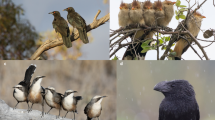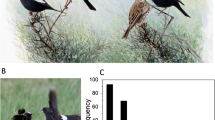Abstract
Tamarins and marmosets are usually described as monogamous, or as living in extended family groups. Field research on a variety of callitrichid species shows, however, that immigration and emigration by adults are common and that groups are likely to be composed largely of unrelated adults of both sexes. Despite the number of adult females present in a group, only a single female is usually reproductively active. This female may mate with more than one male. Care for the young is provided by all group members but principally by adult males. This generally is referred to as a “communal breeding system. ” However, a vertebrate social system in which more than two reproductively active adults participate in infant care is rare and has otherwise been reported only in a small number of avian and canid species. Wild callitrichid groups virtually always include helpers, but the number of adults of each sex is highly variable. We propose that the Callitrichidae tend to live in small multimalemultifemale groups, communally rear the young of one female, and exhibit a mating pattern characterized by female promiscuity but a breeding system that is functionally polyandrous. There is a significant correlation between the number of males and a group and the total number of surviving young. The possible adaptive advantages of this social organization are discussed.
Similar content being viewed by others
References
Abbott, D. H. (1978). The physical, hormonal and behavioral development of the common marmoset,Callithrix jacchus. In Rothe, H., Wolters, H. J., and Hearn, J. P. (eds.),Biology and Behaviour of Marmosets. Eigenverlag H. Rothe, Göttingen, pp. 99–106.
Abbott, O. H. (1984). Behavioral and physiological suppression of fertility in subordinate marmoset monkeys.Am. J. Primatol. 6: 169–186.
Abbott, D. H., McNeilly, A. S., Lunn, S. F., Hulme, M. J., and Burden, F. J. (1981). Inhibition of ovarian function in subordinate female marmoset monkeys(Callithrix jacchus jacchus).J. Reprod. Fertil. 63: 335–345.
Brown, J. (1978). Avian communal breeding systems.Ann. Rev. Ecol. Syst. 9: 123–156.
Cleveland, J., and Snowdon, C. T. (1984). Social development during the first 20 weeks in the cottontop tamarin(Saguinus oedipus oedipus).Anim. Behav. 32: 432–444.
Clutton-Brock, T. H. (1974). Primate social organisation and ecology.Nature (London) 250: 539–542.
Coimbra-Filho, A. F., and Mittermeier, R. A. (1973). Distribution and ecology of the genusLeontopithecus Lesson, 1840 in Brazil.Primates 14:47–66.
Dawson, G. (1976).Behavioral Ecology of the Panamanian Tamarin, Saguinus oedipus(Callitrichidae: Primates), Ph.D. thesis, Michigan State University, East Lansing.
Dawson, G. (1978). Composition and stability of social groups of the tamarin,Saguinus oedipus geoffroyi, in Panama. In Kleiman, D. G. (ed.),The Biology and Conservation of the Callitrichidae, Smithsonian Institution Press, Washington, D.C., pp. 23–38.
Dixon, A. F., and George, L. (1982). Prolactin and parental behaviour in a male New World primate.Nature (London) 299: 551–553.
Emlen, S., and Oring, L. (1977). Ecology, sexual selection, and the evolution of mating systems.Science 197: 215–223.
Epple, G. (1974). Olfactory communication in South American primates.Ann. N. Y. Acad. Sci. 237: 261–278.
Epple, G. (1975). Paternal behavior inSaguinus fuscicollis ssp. (Callitrichidae).Folia primatol. 24: 221–238.
Epple, G. (1978). Reproductive and social behavior of marmosets with special reference to captive breeding.Primates Med. 10: 50–62.
Epple, G., and Katz, Y. (1983). The saddle back tamarin and other tamarins. In Hearn, J. (ed.),Reproduction in New World Primates, MTP Press, Lancaster, England, pp. 115–148.
Epple, G., and Katz, Y. (1984). Social influences on estrogen excretion and ovarian cyclicity in saddle back tamarins(Saguinus fuscicollis).Am. J. Primatol. 6: 155–168.
Evans, S. (1983). The pair-bond of the common marmoset,Callithrix jacchus jacchus: An experimental investigation.Anim. Behav. 31: 651–658.
Freese, C. H., Heltne, P. G., Castro, N., and Whitesides, G. (1982). Patterns and determinants of monkey densities in Peru and Bolivia, with notes on distributions.Int. J. Primatol. 3: 53–90.
French, J. A., and Snowdon, C. T. (1981). Sexual dimorphism in responses to unfamiliar intruders in the tamarinSaguinus oedipus.Anim. Behav. 29: 822–829.
French, J. A., Abbott, D. H., and Snowdon, C. T. (1984). The effect of social environment on estrogen excretion, scent marking and sociosexual behavior in tamarins(Saguinus oedipus).Am. J. Primatol. 6: 155–168.
Garber, P.A. (1980).Locomotor Behavior and Feeding Ecology of the Panamanian Tamarin (Saguinus oedipus geoffroyi,Callitrichidae, Primates), Ph.D. thesis, Washington University, St. Louis.
Garber, P. A., Moya, L., and Malaga, C. (1984). A preliminary field study of the moustached tamarin monkey,(Saguinus mystax) in northeastern Peru: Questions concerned with the evolution of a communal breeding system.Folia primatol. 42: 17–32.
Garber, P. A., and Teaford, M. F. (1986). Body weights in mixed species troops ofSaguinus mystax mystax andSaguinus fusciocollis nigrifrons in Amazonian Peru.Am. J. Phys. Anthropol. 71: 331–336.
Hampton, J. K., Hampton, S. H., and Landwehr, B. T. (1966). Observations on a successful breeding colony of the marmoset,Oedipomidas oedipus.Folia primatol. 4: 265–287.
Hearn, J. P. (1978). The endocrinology of reproduction in the common marmoset,Callithrix jacchus. In Kleiman, D. G. (ed.),The Biology and Conservation of the Callitrichidae, Smithsonian Institute Press, Washington, D.C., pp. 163–172.
Hernandez-Camacho, J., and Cooper, R. W. (1976). The non-human primates of Colombia. In Thorington, R. W., Jr., andHeltne, P. G. (eds.),Neotropical Primates: Field Studies and Conservation, National Academy of Sciences, Washington, D.C., pp. 35–69.
Hershkovitz, P. (1977).Living New World Monkeys (Platyrrhini), Vol. 1, University of Chicago Press, Chicago.
Hoage, R. J. (1978). Parental care inLeontopithecus rosalia rosalia: Sex and age differences and carrying behavior and the role of prior experience. In Kleiman, D. G. (ed.),The Biology and Conservation of the Callitrichidae, Smithsonian Institution Press, pp. 293–305.
Hubrecht, R. C. (1984). Field observations on group size and composition of the common marmoset(Callithrix jacchus jacchus), at Tapacura, Brazil.Primates 25: 13–21.
Hubrecht, R. C. (1985). Home-range size and use and territorial behavior in the common marmoset,Callithrix jacchus jacchus, at the Tapacura field station, Racife, Brazil.Int. J. Primatol. 6: 533–550.
Izawa, K. (1978). A field study of the ecology and behavior of the black-mantled tamarin(Saguinus nigricollis).Primates 19: 241–274.
King, G. (1978). Comparative feeding and nutrition in captive, non-human primates.Br. J. Nutr. 40: 55–62.
Kinzey, W. G.(1979). Marmosets and tamarins.Science 203–879.
Kirkwood, J. K., Epstein, M. A., and Terlecki, A. J. (1983). Factors influencing population growth of a colony of cotton-top tamarins.Lab. Anim. 35: 35–41.
Kleiman, D. G. (1977). Monogamy in mammals.Q. Rev. Biol. 52: 39–69.
Kleiman, D. G. (1978). The development of pair preferences in the lion tamarin(Leontopithecus rosalia). In Rothe, H., Wolters, H. J., and Hearn, J. P. (eds.),Biology and Behaviour in Marmosets, Eigenverlag H. Rothe, Göttingen, pp. 203–207.
Kleiman, D. G. (1979). Parent-offspring conflict and sibling competition in a monogamous primate.Am. Nat. 194: 753–760.
Leutenegger, W. (1979). Evolution of litter size in primates.Am. Nat. 114. 525–531.
Leutenegger, W. (1980). Monogamy in callitrichids: A consequence of phyletic dwarfism.Int. J. Primatol. 1: 95–98.
Lindsay, N. B. D. (1979). A report on the field study of Geoffroyi’s tamarinSaguinus oedipus geoffroyi.Dodo, J. Jersey Wild. Preserv. Trust 16: 27–51.
Malaga, C. (1985). Nonstandard mating systems forSaguinus mystax.Am. J. phys. Anthrop. 66: 201.
Michael, R. P., and Zumpe, D. (1971). Patterns of reproductive behavior. In Hafez, E. S. E. (ed.),Comparative Reproduction of Nonhuman Primates, Thomas, Springfield, III., pp. 205–242.
Mittermeier, R. A., and Coimbra-Filho, A. F. (1981). Systematics: Species and subspecies. In Coimbra-Filho, A. F., and Mittermeier, R. A. (eds.),Ecology and Behavior of Neotropical Primates, Vol. I, Academia Brasileira de Ciéncias, Rio de Janeiro, pp. 29–110.
Mittermeier, R. A., and van Roosmalen, M. G. M. (1981). Preliminary observations on habitat utilization and diet in eight Surinam monkeys.Folia primatol. 36: 1–39.
Moynihan, M. (1970). Some behavior patterns of platyrrhine monkeys. II.Saguinusgeoffroyi and some other tamarins.Smithson. Contrib. Zool. 28: 1–77.
Moynihan, M. (1976).The New World Primates, Princeton University Press, Princeton, N.J.
Neyman, P. (1978). Aspects of ecology and social organization of free ranging cotton-top tamarins(Saguinus oedipus) and the conservation status of the species. In Kleiman, D. G. (eds.),The Biology and Conservation of the Callitrichidae, Smithsonian Institution Press, Washington, D.C., pp. 39–72.
Ramirez, M. (1984). Population recovery in the moustached tamarin(Saguinus mystax): Management strategies and mechanisms of recovery.Am. J. Primatol.7: 245–259.
Ramirez, M. F., Freese, C. H., and Revilla, J. (1978). Feeding ecology of the pygmy marmoset,Cebuella pygmaea, in northeastern Peru. In Kleiman, D. G. (ed.),The Biology and Conservation of the Callitrichidae, Smithsonian Institution Press, Washington, D.C., pp. 91–104.
Rothe, H. (1975). Some aspects of sexuality and reproduction in groups of captive marmosets(Callithrix jacchus).Z. Tierpsychol. 37: 37: 255–273.
Rylands, A. B. (1981). Preliminary field observations on the marmoset,Callithrix humeralifer intermedius (Hershkovitz, 1977) at Dardanelos, Rio Aripuana, Mato Grosso.Primates 22: 46–59.
Skutch, A. F. (1961). Helpers among birds.Condor 63: 198–226.
Soini, P. (1981). Informe de Pacaya No. 4: Ecoglia dinámica poblacional del pichico S.fuscicollis (Primates, Callitrichidae). Dirección Regional de Agricultura y Alimentacion Iquitos, Peru.
Soini, P. (1982a). Informe de Pacaya No. 6: Distribucion, geografia y ecologia poblacional de S.mystax (Primates, Callitrichidae). Dirección Regional de Agricultura y Alimentation, Iquitos, Peru.
Soini, P. (1982b). Ecology and population dynamics of the pygmy marmoset,Cebuella pygmaea.Folia primatol. 39: 1–21.
Soini, P. (1985). Ecology ofSaguinus fuscicollis illigeri at Pacaya, Northeastern Peru. Paper presented at the 54th Annual Meetings of the American Association of Physical Anthropology, Knoxville, Tenn.
Stacey, P. B. (1979). Kinship, promiscuity, and communal breeding in the acorn woodpecker.Behav. Ecol. Sociobiol. 6: 53–66.
Stacey, P. B. (1982). Female promiscuity and male reproductive success in social birds and mammals.Am. Nat. 120: 51–64.
Stevenson, M. F., and Rylands, A. B. (1986). The marmoset monkeys, genusCallithrix. In Coimbra-Filho, A. F., and Mittermeier, R. A. (eds.),Ecology and Behavior of Neotropical Primates, Vol. 2, Academia Brasileira de CiÊncias, Rio de Janeiro (in press).
Sussman, R. W., and Kinzey, W. G. (1984). The ecological role of the Callitrichidae: A review.Am. J. phys. Anthrop. 64: 419–449.
Sutcliffe, A. G., and Poole, T. B. (1984). An experimental analysis of social interactions in the common marmoset(Callithrix jacchus jacchus) Int. J. Primatol. 5: 591–607.
Tardif, S. D. (1984). Social influences on sexual maturation of femaleSaguinus oedipus oedipus.Am. J. Primatol. 6: 199–210.
Tardif, S. D., Richter, C. B., and Carson, R. L. (1984). Effects of sibling-rearing experience on future reproductive success in two species of Callitrichidae.Am. J. Primatol. 6: 377–380.
Terborgh, J. (1983).Five New World Primates: A Study in Comparative Ecology, Princeton University Press, Princeton, N.J.
Terborgh, J., and Goldizen, A. (1985). On the mating systems of the cooperatively breeding saddle-backed tamarin(Saguinus fuscicollis) Behav. Ecol. Sociobiol. 16: 293–299.
Thorington, R. W. (1968). Observations of the tamarin,Saguinus midas.Folia primatol. 9: 95–98.
Wickler, W., and Seibt, U. (1983). Monogamy: An ambiguous concept. In Bateson, P. (ed.),Mate Choice, Cambridge University Press, Cambridge, pp. 33–50.
Wolfenden, G. E., and Fitzpatrick, J. W. (1984).The Florida Scrub Jay: Demography of a Cooperative Breeding Bird, Princeton University Press, Princeton, N.J.
Yoneda, M. (1984). Ecological study of the saddle back tamarin(Saguinus fuscicollis) in Northern Bolivia.Primates 25: 1–12.
Author information
Authors and Affiliations
Additional information
An erratum to this article is available at http://dx.doi.org/10.1007/BF02737392.
Rights and permissions
About this article
Cite this article
Sussman, R.W., Garber, P.A. A new interpretation of the social organization and mating system of the Callitrichidae. Int J Primatol 8, 73–92 (1987). https://doi.org/10.1007/BF02737114
Received:
Revised:
Issue Date:
DOI: https://doi.org/10.1007/BF02737114




